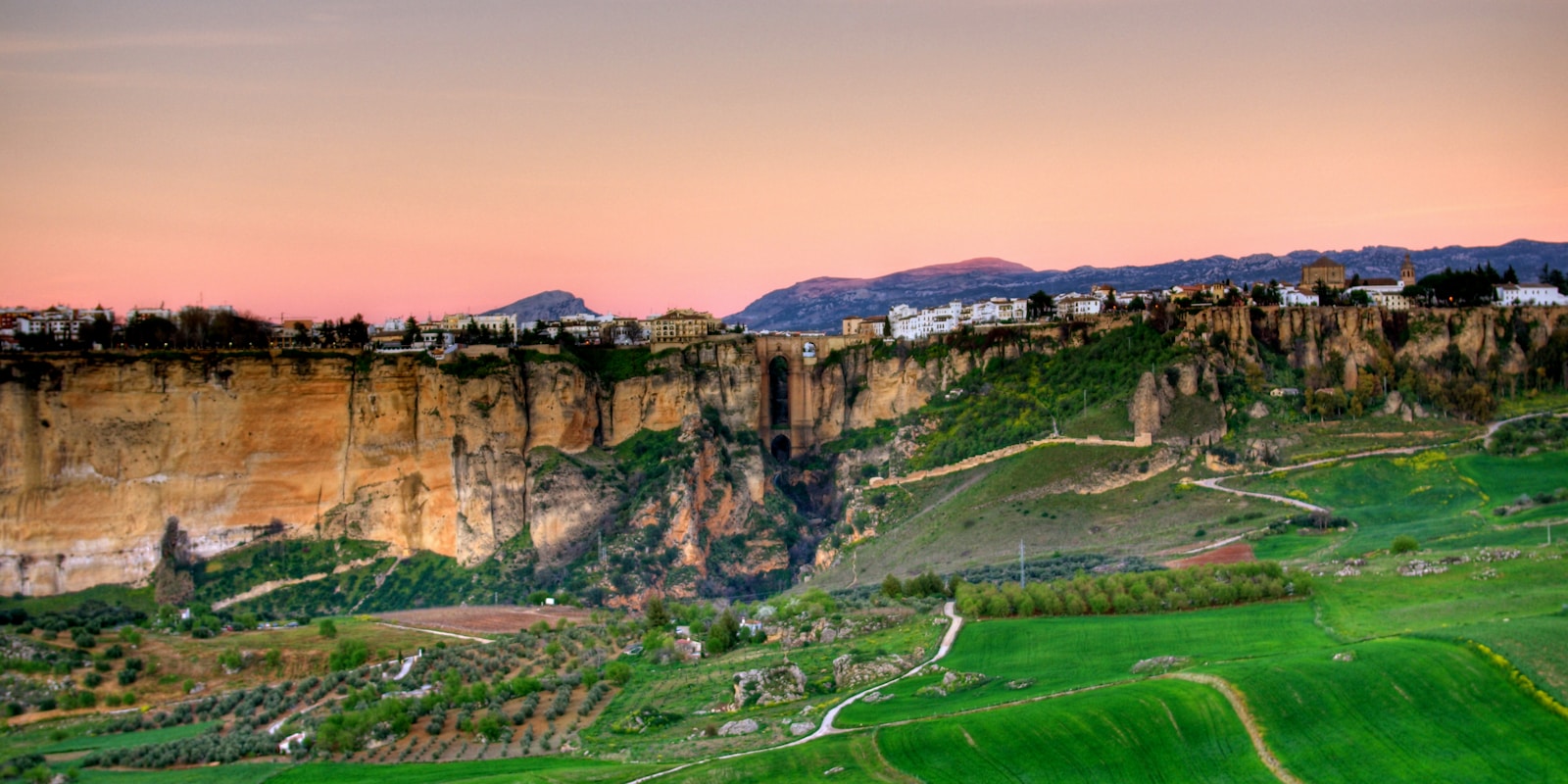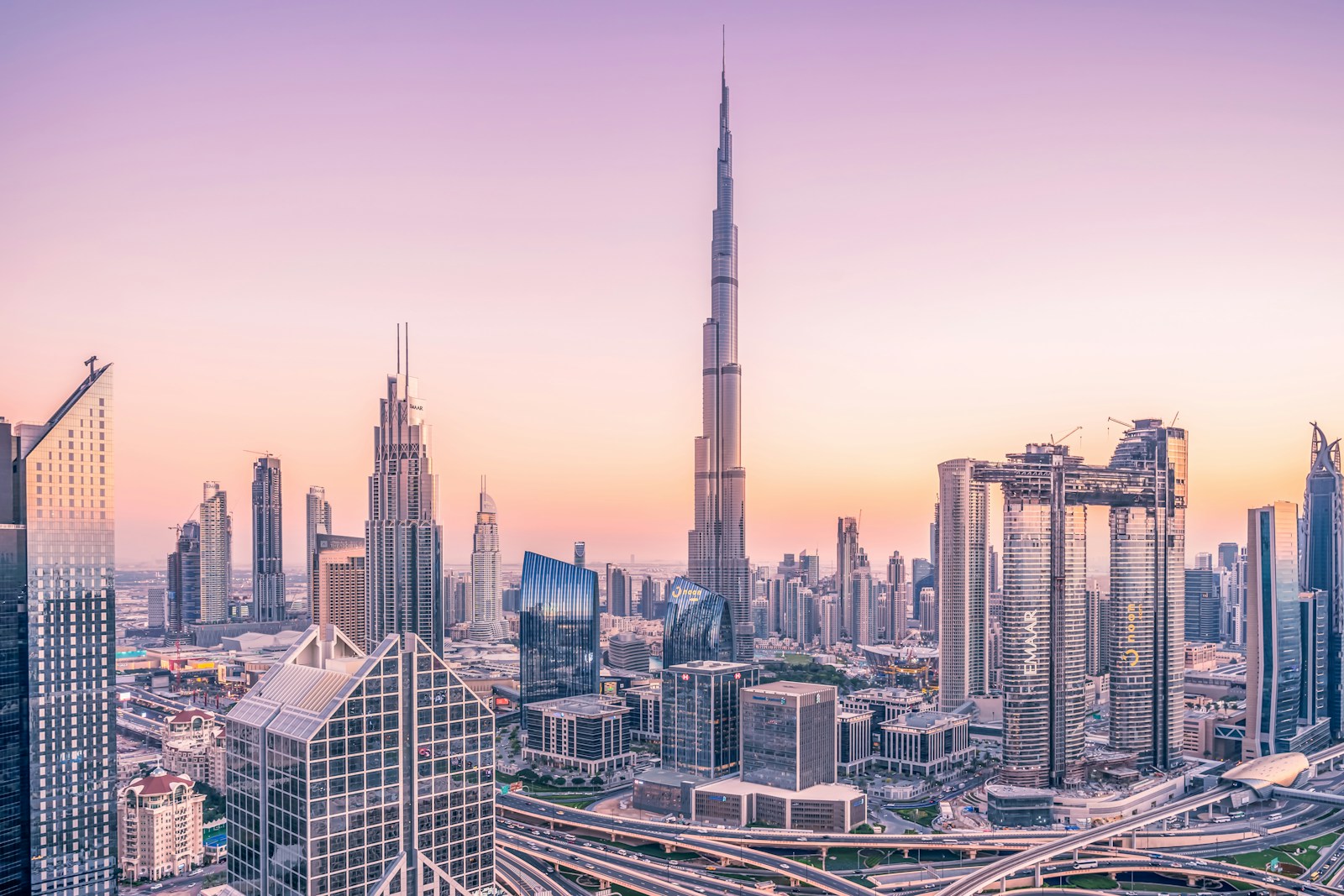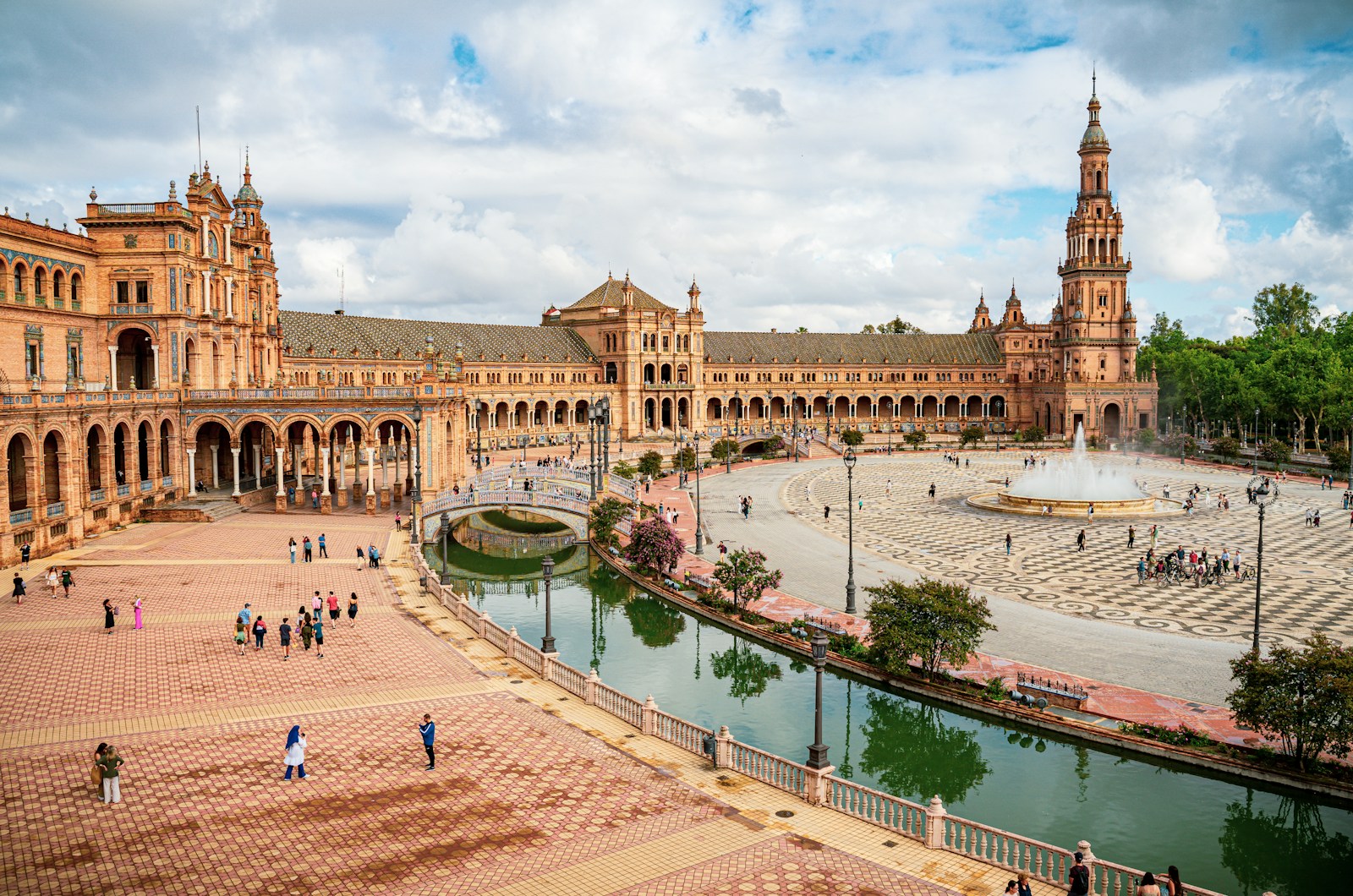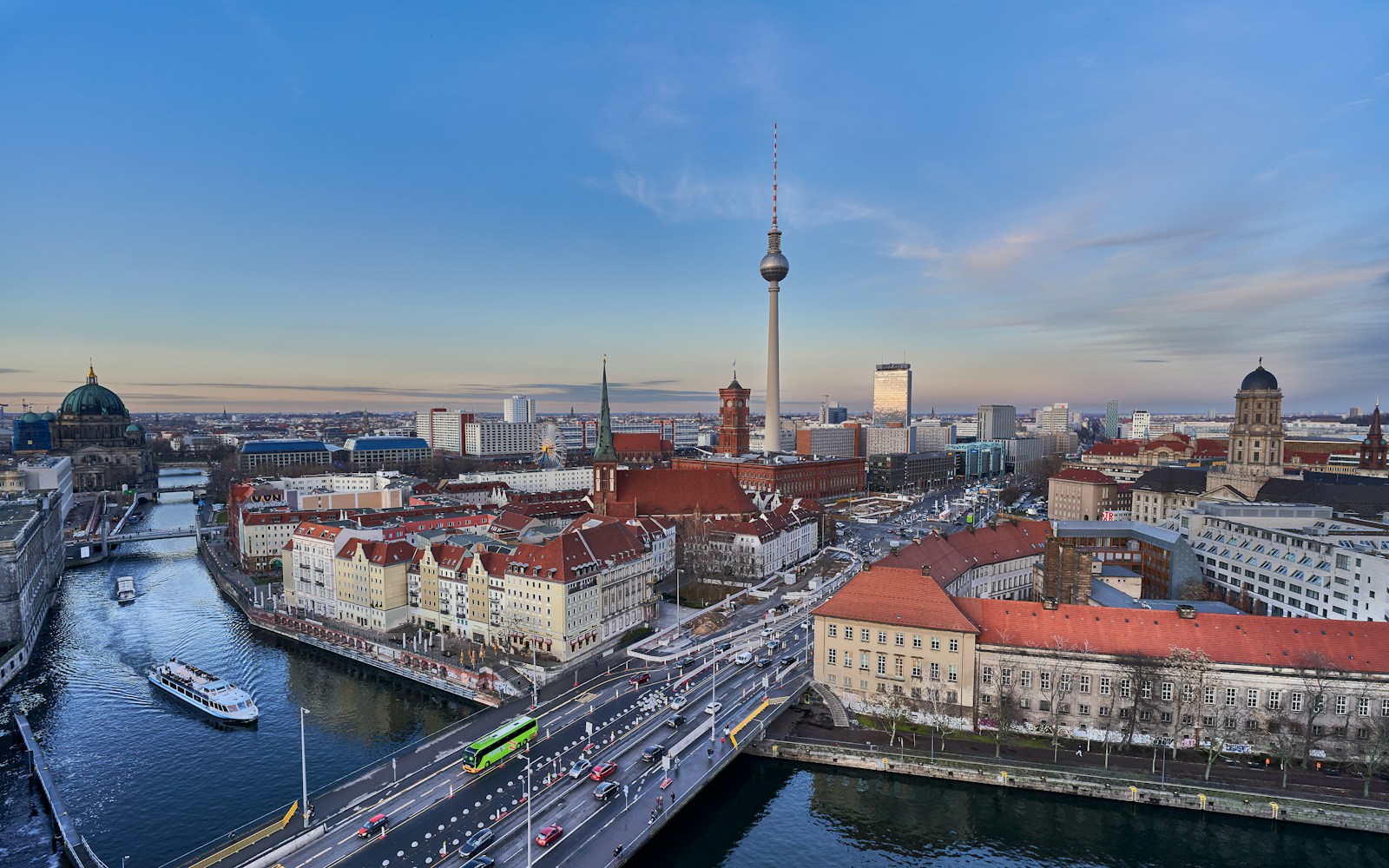Ronda – a beautiful city located in Andalusia, Spain is perfect for a historical and cultural trip as well as for Mother Nature’s lovers. The city situated very close to a steep cliff looks very inviting and interesting with its colourful history and striking views. When you are walking through the historical city of Ronda you are getting into the past as the town with roots going back to 15th century has narrow streets paved with stones combined with stunning views. This article is a guide to the most important ten-for-visit places in Ronda which all have variegated histories and offer the visitor an incredible experience of this amazing city.
New Bridge of Ronda: Marvel of Engineering
The New Bridge or in Spanish ‘the Puente Nuevo’ is not a simple link or passage between two areas of the town , but a historical landmark of the town and one of the major attractions that define the architecture of the town of Ronda. The bridge was built over 42 years from 1751 to 1793 and is 98 meters high with a purpose of crossing the marvelous gorge of Tajo de Ronda created by the Guadalevín River. Its construction was a miracle of the construction available in the 18th century and saw great architectural designs at that time. The bridge is solid stone which incorporates the arches that marked the construction style of the age, and above all, the spirit of the people of Ronda did not surrender to the odds of the course of the river.
For more than what it is a bridge, the Puente Nuevo is a historical eye-witness. It was an important city accomplishment, because it connected the Moorish part of the city which constitutes the old town, to the new sections of the city which were build during the period of the city’s economic growth. The infotainment space available in the Interpretation Centre inside the bridge helps the visitors to understand the details about the construction and issues encountered during the construction, and usability of the bridge in the spatial fabric of Ronda. The educational role contributes to the improvement of the final experience since it provides the visitor with historical context about the bridge.
Moreover, due to their role the bridge remains a cultural center where great events attracting people from both the region and other countries are held. Over the length of its bridges, some of which are up high, one gets breathtaking views of the surrounding countryside, making it a photographer’s delight as well as one of Ronda’s top tourist attractions. The conjunction of nature and design+ The juxtaposition of the scenic nature and the structural size and beauty of the Puente Nuevo brings out the standard essence of the city.
Ronda Bullring:
Located within the building is one of the most historic landmarks, the clock above the entrance is crucial and dates back many years.
The Ronda Bullring also referred to as Plaza de Toros de Ronda is one of the oldest as well as being one of the most important bullrings in Spain. Although this site is mostly known as the place for bullfighting established in 1785, it is more than just that – it is the part of the culture which is considered controversial but important for the population. The bullring was also constructed by José Martín de Aldehuela who also has the credit of designing the famous Puente Nuevo. In looking at the architecture of the bullring, it stands to be an example of a neoclassical meaning style that embodies much of its simplicity and also being symmetrical. The Brazilian ring is 66 meters in diameter, and enclosing it is a two-tier arcade which plays not only a practical role but also plays the ornamental function.
It is more so if Ronda’s bull ring, which is acknowledged to be one of the oldest and most famous bull rings in the world today is considered and placed against the backdrop of the development of the modern bullfight. This is where the Real Maestranza de Caballería de Ronda nailed the mechanisms and the manner of bull fighting on foot, from the prior established modes of bull fighting on horse back. This change is important as it helped form the modern characteristic of the sport and due to that makes Ronda a very important place in the history of bullfighting. Currently, the bullring is home to innumerable famous matadors and is a place where the true spirit and colorful passion of bullfighting is maintained.
Bullring itself cordoned off, there is a museum, Museo Taurino, outside which has a rich Bullfighting collection as costumes, weapons, photographs etc. The museum explains all aspects of the sport, its historical development, social role and function, and the scandals associated with it. It is a cultural facility that inform tourists on various customs about bullfighting and is also a place where people can engage in debates about the morality of that sport.
House of the Moorish King: The History in the Glass The Souvenir as a Medium of Memory
The Casa del Rey Moro or the House of the Moorish King is also one of the famous building that depicts the richness of Ronda. In point of fact, the house that is associated with links to Moorish royalty was built in the 18th century, much later than the period of Muslim Spain. Neo-Mudejar, the style in whichthe house was constructed, refers back to the Islam impact that had always been in Andalusia while combining this style with the Baroque and Neoclassical styles that were popular at the time. This hybrid of architectural forms imbues the Casa del Rey Moro with a certain character; it becomes a very interesting example of the architects’ work in the context of the region’s history.
It is a water mine one of the most amazing elements of the house; a successful product of medieval hydraulic science. Facing the river of Guadalevín, the mine is designed as the set of 365 steps cut into the rock to reach the water supply so necessary during sieges. This feature not only serves the constructive functionality of its creators on the approach to problem solving but also gives the tourists an effect of an incredible adventure, lowered into the mines. Historically, the water mine has enormous value as a component of the construction, as well as indicating the thinking and actions of the people of Ronda during the time of war.
The partitions contain the gardens of the Casa del Rey Moro, commissioned to the French landscape designer Jean Claude Nicolas Forestier and that presents a peaceful airs with its Hispano-Muslim-French gardens. The gardens have nice view of Ronda landscapes and therefore makes it suitable to contemplate and have a peaceful place to rest. Despite these gardens being manmade the manner in which they are constructed and maintained is uniquely tasteful, and brings serenity to the place; this itself is worth the visit to Ronda.
Mondragon Palace: A piece of history.
This is a building that gives the history buffs a front row view of Ronda; it is the Mondragon Palace or more specifically the Palace of the Marquis of Villasierra. A beautiful Gothic palace from the 14th century, it offers Mudejar architecture with intricate tile murals, wooden sybols, and the Islamic/Christian mix. The palace represents multiple cultures and for that matter Multiple cultures were in Ronda when this palace was built and more specificity Muslim, Christians and Jews were living in Ronda.
The historical requirement of the structure is even more prominent when it comes to the fact that it served as the palace of the Muslim king Abomelic. This narrative configures the palatial house as an ideal site for comprehending Ronda’s medieval architecture that encompasses a wealth of Moorish influences. Several generations of rulers also caused renovations and new construction in the palace adopting the Renaissance and Baroque styles of the epoch. Its layout and the range of architectural themes represent a historical and cultural summary of Ronda in the building known as Mondragon Palace.
Today, the palace house the Ronda Museum and city Archaeological museum which is stocked with actuality that ranges from the pre-history to the more historic moorish influence period. Some of the collections gathered in the museum embrace archaeology, art and other items within the history of daily use by the inhabitants of Ronda. Anticipating the importance of visual awareness of the palace gardens, which are located on the adjacent territory, and the magnificent views of the mountains, the design aimed at creating a contemplative environment promoting admiration of the city history and its natural landscape.
Arab Baths of Ronda: A Restoration of Rebekah’s Youth
The Arab Baths of Ronda is a very well maintained portion remaining from the city’s Islamic past situated close to its old Puerta de Almocábar. Located within the ancient city, these baths date back to the 13th century and the Nasrid kingdom; such a hammams are scarce in the area. The baths are laid in a way which can be described as traditional that is there are separate rooms for cold, warm, and hot baths. Such division can be explained by the existence of Roman and Ottoman traditions of bathing, indicating the essence of multicultural Andalusia’s historical experience.
The architectural structure of baths is characterized by star-shaped skylights, and thus the interior is filled with natural light at the same time giving a mysterious look. Along with these skylights the arched ceilings supported on columns throw light on the Islamic architectural style that dominated the geometric models and detailings. The means of heating, a hypocaust, an ancient advanced type of heating inherited from the Romans, prove consciousness of high technologic development.
Moving on from a historical viewpoint, it is crucial and instructive to note that the Arab Baths of Ronda are an arts of culture point, seeing that they give a feel of some of the typical facets of mediaeval Ronda. This was also a more social experience where they could meet other people, practice purification which can also be connected to beliefs of Islam where cleanliness is highly valued. Nowadays there are many cultural and educational activities in the place: ideas and history of the city and Andalusia region may be studied here.
Blas Infante Walk and its Viewpoint: The Prospect of a Panorama
Blas Infante aisle; it is a paved pathway in honor of the father of Andalusian nationalism that provides some of the best views of Ronda’s scenery. [Their] walkway is situated where they can once again get a perfect view of the bridge, the Tajo de Ronda gorge and the greenery on the farther side. The styling of the promenade complements the natural sceneries so that a visitor is able to capture the natural beauty of the environment.
The viewpoint is frequently visited by the tourists as well as the locals, mostly in the evenings, to enjoy the view of the setting sun on city’s buildings and other geographical landmarks. This is the best time for photography since the whole of Ronda is pretty giving and scenic in equal measures. Blas Infante walk is not only walkway to look around from one point to other, but a place that buzzes with different events and festivals all year round. These are events that include music concerts, local celebrations and this has made promenade to be active and full of life.
Duchess of Parcent Square: That is a historic hub
Duquesa de Parcent is an important central plaza in the new historic part of Ronda city. Originally, they consider it to be the location of the Roman Forum and today, the square and its immediate vicinity is home to significant structures that attest to Rome’s history. Presiding over the square is the Church of Santa María la Mayor that is an excellent example of religious architecture of the city. Constructed during Muslim dominion in the city as a mosque the church was transformed into Christian place in 1485 after the Spanish Reconquista. The church contains such Arts as Gothic, Renaissance and Baroque which represent such cultural and religious reforms that ronda has passed through.
The Town Hall the other landmark building is located on the square was built as a military prison in 1734. It is today used as a governmental building which underlines the versatility and the tradition of the architecture of Ronda. Other structures of architectural and historical interest include the Charity Sisters of the Cross Convent, and St. Elizabeth of the Angels’ Poor Clares’ convent. They are also other religious institutions that help to make the square Santos and spiritual for the people.
Besides being a historical place, Plaza Duquesa de Parcent has social functionality as well. Its gardens and other shaded parts of the building give a place of relaxation and make a perfect venue for social events. Thus, the square can be a location for festivals, markets, and cultural performances, turning into a vibrant core of Ronda’s life.
Almocábar Gate and the Wall:
It is necessary to stress that such approaches can be used and are actively used in various branches of knowledge, for example, in the study of historical fact by its guardians – historians.
Almocábar Gate with the rest of the city wall can be considered as the examples of the historical part of Ronda relating to medieval period. There is of course the gate on the southern side of the old town somewhat older at least parts from the 13th century and used as one of the entrance to the city during the Muslim period. This gate for instance is basically a fine example of Islamic military architecture in the sense that it is roughly built with a certain level of reinforcement and strategically located. This gate had the main function as one of the gates that defended the city of Ronda against a possible invasion.
An old town has been fortified and was enclosed by a city wall, which circumscribed the entire complex that was necessary for the construction of the settlement. Some of the sections of the wall now such as in the Almocábar Gate give an insight into the city’s historical past involved in defense of the region. Concerning the form of the wall, it has certain practical aspect that has to do with medieval warfare, particularly in medieval England — there are battlements and towers that served as strategic posts.
Currently, tourists and history lovers visit it to enjoy and learn more on the medieval history of Ronda especially in the Almocábar Gate and the wall. They are part of historical and cultural routes of the city and allow to get acquainted with the atmosphere of the past. The gate and wall are open for the public use; thus, these may be good stops for visitors who wish to learn.
Socorro Square: The meeting place; culture and activity.
Socorro Square is one of the central squares in Ronda that also has lots of historical and cultural references. During the second Spanish Republic in the 20th century, it was used for political and social meetings and became the central meeting point. The square has also several important buildings it has sophisticated architecture and it is beautiful with the Casino and the Círculo de Artistas. These establishments are the examples of the architectural trends of their construction time and contribute to the historical appearance of the square.
One can characterize Plaza del Socorro as having the monument to Blas Infante, who was the father of Andalusian nationalism. This memorial is a representation not only to one of the most significant personalities in the history of Andalusia, but also and especially to the culture and political aspect of the region. The square is in great use; there are various events that take place as well as celebrations in the course of the year. Besides buying and selling, people go there to attend various events, including concerts and performances Plaza del Socorro is one of the most active premises in the town frequented by both, the Spaniards and the foreigners.
House of St. John Bosco:
This was to be a stately residence, not something of a mean character, directed towards the production of small articles for common use.
The Casa de San Juan Bosco is a fine example of an early twentieth-century house located on the border of the Tajo de Ronda. The house was erected in a modernist manner with motifs of Nasrid art; it was a testimony to the multi-style tendencies in architecture of that time. This building was given to the Salesians by Doña Dolores Granadinos in memory of St. John Bosco an essential founder and participant in the Salesian movement.
His provisional house has the grand decorations, marvellous marble floors, and a splendid central staircase. The inside is furnished in a way that reflects the style of the beginning of the XX century, with items unique to the Andalusian nobility of the epoch. Certainly, the spectacular element of Casa de San Juan Bosco is the hanging garden, which is orientated towards the wonderful view of the Tajo de Ronda and the surrounding territory.
The house plays a social function as cultural center that accommodates different events and show casing of works of art related to the cultural wealth of Ronda. The Casa de San Juan Bosco can therefore be said to be a must-visit center of history and culture through which people can interactively appreciate the present and past of Ronda.
Conclusion: Ronda’s Timeless Allure
Ronda is a beautiful city that has managed to preserve its history and traditions, and combine them with outstanding nature, so visiting Ronda in Andalusia is more than a wise decision. Every sight and building in Ronda narrates a different story associated with the city distinctive background. Starting with the majestic Puente Nuevo up to the beautiful gardens of Casa del Rey Moro. Artistic performances, colonial buildings, and beautiful landmarks leave the visitors with an out of a tangible experience. If you aim for the historical sites or walking around the cobblestone alleys or simply the breath taking views of the nature of Rond a trip is unforgettable.




